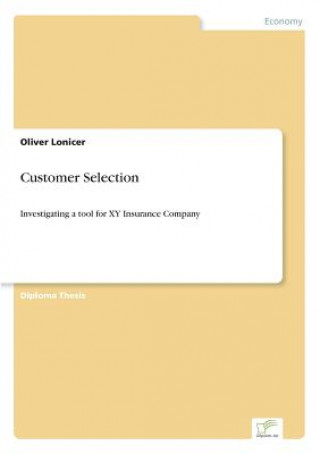
Delivery
Shopping guide





Doesn't suit? No problem! You can return within 30 days
 Gift voucher
any value
Gift voucher
any value
You won't go wrong with a gift voucher. The gift recipient can choose anything from our offer.
Customer Selection
 English
English
 346 b
346 b
 Delivery to Austria
Delivery to Austria
30-day return policy
You might also be interested in


Inhaltsangabe:Abstract: żIn the real world, all customers are not created equal.ż This allusion to the Declaration of Independence captures a recent realisation of many companies - different customers represent different values to a company. In fact, many companies are discovering that a large percentage of their customers are generating losses. XY Insurance is among those companies that recently discovered a considerable portion of unprofitable customers in their current book of business. This was identified as a major problem, especially considering the fact that the company is converting to a publicly traded stock company. Given the necessity to produce shareholder value, senior management realised that it would be indispensable to ensure the profitability of its accounts. One of the factors underlying this problem at XY is the lack of a screening process to ensure the selection of customers with whom a profitable relationship can be built. To address this need, XY's senior management decided that it would be necessary to develop a tool that enables the sales staff to evaluate customers, and ultimately, to select customers based an this assessment. The objective of this study is the development of a screening tool which can be used as a basis for the selection of XY's customers in the company's arge case segment. The development of the tool is limited to one of the company's segments because the customers as well as the products differ greatiy by segment. The tool should enable the company to assess their clients individually and classify each of them as 'attractive' or 'unattractive' so that proper strategies can be applied. The strategy development lies outside of the confines of this study and is therefore not discussed in this paper. I will however, indicate starting-points and some important issues when designing these strategies. In addition, considerations in conjunction with the implementation and introduction process, as well as avenues for further research are addressed where appropriate. White the initial idea behind the development of the screening tool was to design a mechanism that would allow for the assessment of all of XY's customers, existing and prospective, it became apparent that this would not be feasible. Separate tools for both stages are needed. As a result it was decided that a model outlining the needed criteria would be developed, and based an this a screening tool for prospective clients, would be built. The design of the assessment tool for existing clients will follow at a later stage. The conceptual framework established in this thesis has to encompass the requirements of both intended uses. As a result, the first objective of this study is to generate a sound model for client selection at XY, which establishes the general requirements for client selection and thus builds the foundation for the tools. The second objective of this study is the development of the client selection tool for prospective clients. The development of both tools is not feasible within the scope of this study. The second chapter provides an introduction to the group insurance business and to XY Insurance. The first section of this chapter was included because group insurance does not exist in Germany and as a result, most Germans are not familiar with the concept. The second part of this chapter provides an introduction to XY Insurance for those not acquainted with the company. The chapter also addresses the Canadian group insurance market and its characteristics. Chapter three discusses the theory of customer selection and its significance in today's business practice. The chapter is divided into two parts: section 3.1 outlines the context in which the topic falls, while section 3.2 contains a detailed discussion of customer selection in theory. Chapter four describes the methodology, implementation, and results of this st...
About the book
 English
English


 Contact
Contact How to shop
How to shop
































